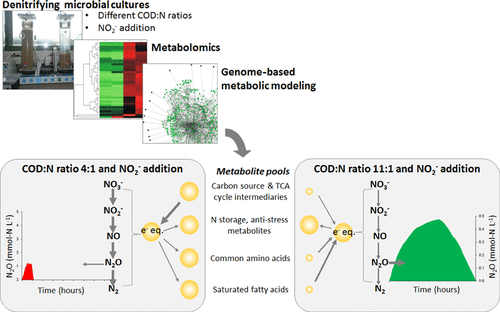当前位置:
X-MOL 学术
›
Environ. Sci. Technol.
›
论文详情
Our official English website, www.x-mol.net, welcomes your feedback! (Note: you will need to create a separate account there.)
Modulation of Nitrous Oxide (N2O) Accumulation by Primary Metabolites in Denitrifying Cultures Adapting to Changes in Environmental C and N
Environmental Science & Technology ( IF 11.4 ) Pub Date : 2017-11-16 00:00:00 , DOI: 10.1021/acs.est.7b03345 Octavio Perez-Garcia 1 , Cody Mankelow 1 , Kartik Chandran 2 , Silas G. Villas-Boas 3 , Naresh Singhal 1
Environmental Science & Technology ( IF 11.4 ) Pub Date : 2017-11-16 00:00:00 , DOI: 10.1021/acs.est.7b03345 Octavio Perez-Garcia 1 , Cody Mankelow 1 , Kartik Chandran 2 , Silas G. Villas-Boas 3 , Naresh Singhal 1
Affiliation

|
Metabolomics provides insights into the actual physiology of cells rather than their mere “potential”, as provided by genomic and transcriptomic analysis. We investigate the modulation of nitrous oxide (N2O) accumulation by intracellular metabolites in denitrifying bacteria using metabolomics and genome-based metabolic network modeling. Profiles of metabolites and their rates of production/consumption were obtained for denitrifying batch cultures under four conditions: initial COD:N ratios of 11:1 and 4:1 with and without nitrite spiking (28 mg-N L–1). Only the nitrite-spiked cultures accumulated N2O. The NO2– spiked cultures with an initial COD:N = 11:1 accumulated 3.3 ± 0.57% of the total nitrogen added as N2O and large pools of tricarboxylic acid cycle intermediates and amino acids. In comparison, the NO2– spiked cultures with COD:N = 4:1 showed significantly higher (p = 0.028) N2O accumulation (8.5.3 ± 0.9% of the total nitrogen added), which was linked to the depletion of C11–C20 fatty acids. Metabolic modeling analysis shows that at COD:N of 4:1 the denitrifying cells slowly generate electron equivalents as FADH2 through β-oxidation of saturated fatty acids, while COD:N of 11:1 do it through the TCA cycle. When combined with NO2– shock, this prolonged the duration over which insufficient electron equivalents were available to completely reduce NOx to N2, resulting in increased N2O accumulation. Results extend the understanding of how organic carbon and nitrite loads modulate N2O accumulation in denitrification, which may contribute to further design strategies to control greenhouse gas emissions from agricultural soils or wastewater treatment systems.
中文翻译:

适应环境C和N变化的反硝化培养物中主要代谢产物对一氧化二氮(N 2 O)积累的调节
代谢组学提供了对细胞实际生理学的见识,而不仅仅是基因组和转录组学分析所提供的“潜能”。我们使用代谢组学和基于基因组的代谢网络模型,研究反硝化细菌中细胞内代谢产物对一氧化二氮(N 2 O)积累的调节作用。在以下四个条件下,对分批培养物进行反硝化处理时,获得了代谢物的概况及其生产/消耗速率:初始COD:N比率为11:1和4:1(有和没有亚硝酸盐加标(28 mg-N L –1))。只有亚硝酸盐掺入培养氮累积2 O的NO 2 -掺料培养物的初始COD:N = 11:1 3.3积累±0.57总氮的%加入如N-2 O和大量的三羧酸循环中间体和氨基酸。相比较而言,NO 2 -掺料培养物COD:N = 4:1显著较高表明(p值= 0.028)N 2 ö积累,将其链接到的耗尽(添加的总氮8.5.3±0.9%) C11–C20脂肪酸。代谢模型分析表明,在4:1的COD:N下,反硝化细胞通过饱和脂肪酸的β-氧化作用缓慢生成电子当量,如FADH 2,而在TCA循环中,COD:N为11:1。当与NO 2 –冲击结合使用时,这会延长持续时间,在这段时间内无法获得足够的电子当量以将NOx完全还原为N 2,导致N 2 O积累增加。结果扩展了对有机碳和亚硝酸盐负荷如何调节反硝化过程中N 2 O积累的理解,这可能有助于控制农业土壤或废水处理系统的温室气体排放的进一步设计策略。
更新日期:2017-11-17
中文翻译:

适应环境C和N变化的反硝化培养物中主要代谢产物对一氧化二氮(N 2 O)积累的调节
代谢组学提供了对细胞实际生理学的见识,而不仅仅是基因组和转录组学分析所提供的“潜能”。我们使用代谢组学和基于基因组的代谢网络模型,研究反硝化细菌中细胞内代谢产物对一氧化二氮(N 2 O)积累的调节作用。在以下四个条件下,对分批培养物进行反硝化处理时,获得了代谢物的概况及其生产/消耗速率:初始COD:N比率为11:1和4:1(有和没有亚硝酸盐加标(28 mg-N L –1))。只有亚硝酸盐掺入培养氮累积2 O的NO 2 -掺料培养物的初始COD:N = 11:1 3.3积累±0.57总氮的%加入如N-2 O和大量的三羧酸循环中间体和氨基酸。相比较而言,NO 2 -掺料培养物COD:N = 4:1显著较高表明(p值= 0.028)N 2 ö积累,将其链接到的耗尽(添加的总氮8.5.3±0.9%) C11–C20脂肪酸。代谢模型分析表明,在4:1的COD:N下,反硝化细胞通过饱和脂肪酸的β-氧化作用缓慢生成电子当量,如FADH 2,而在TCA循环中,COD:N为11:1。当与NO 2 –冲击结合使用时,这会延长持续时间,在这段时间内无法获得足够的电子当量以将NOx完全还原为N 2,导致N 2 O积累增加。结果扩展了对有机碳和亚硝酸盐负荷如何调节反硝化过程中N 2 O积累的理解,这可能有助于控制农业土壤或废水处理系统的温室气体排放的进一步设计策略。


























 京公网安备 11010802027423号
京公网安备 11010802027423号